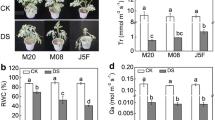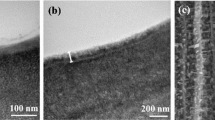Abstract
The composition of the cuticular wax varies from species to species as well as the developmental stage of the organ. In the present study, the variation in the pattern of accumulation of C28 and > C28 chain length of the cuticular wax compounds in the two contrasting Musa species for wax content has been examined—Musa balbisiana ‘Bee heekela’ (BB genome) (with high wax content) and Musa acuminata ssp. Burmannicoides Colla—‘Calcutta-4’ (AA genome) (with low wax content). These two species are the progenitors for the modern cultivated banana. Using GC–MS analysis, 40 different cuticular wax compounds from five different leaf developmental stages in these two musa species were identified. Around tenfold higher accumulation of C28 length compounds was found in ‘Calcutta-4’ as compared to that of ‘Bee hee kela’. In case of ‘Bee hee kela’, > C28 length compounds were in large proportion compared to C28 length wax compounds. The qPCR analysis was carried out for the gene CUT1/CER6/KCS6 which are involved in the fatty acid elongation step of cuticular wax biosynthesis. A higher expression in the 2nd (young), 4th and 6th (old) fully expanded leaves of high wax genotype ‘Bee hee kela’ with 1.57083, 9.71512, and 1.44963 fold change, whereas a lower expression of 0.9151, 4.8785, and 1.2321 fold change in low wax genotype ‘Calcutta-4’, respectively, was observed. A negative relationship between the gene expression and C28 wax compounds’ accumulation was observed, indicating the importance of the expression of CUT1/CER6/KCS6 gene for elongation of C28 to > C28 cuticular wax compounds. The current study suggest that CUT1/CER6/KCS6 from ‘Bee heekela’ would be a good contributor for higher cuticular wax with higher > C28 compounds, thus, finally, contributing for higher leaf water retention capacity their by conferring drought tolerance helping in the future banana improvement programs.



Similar content being viewed by others
References
Albanes D, Heinonen OP, Taylor PR, Virtamo J, Edwards BK, Rautalahti M, Barrett MJ (1996) α-Tocopherol and β-carotene supplements and lung cancer incidence in the Alpha-Tocopherol, beta-carotene cancer prevention study: effects of base-line characteristics and study compliance. J Natl Cancer Inst 88(21):1560–1570
Bakker MI, Baas WJ, Sijm DT, Kolloffel C (1998) Leaf wax of Lactuca sativa and Plantago major. Phytochemistry 47(8):1489–1493
Bauer S, Schulte E, Their HP (2004) Composition of the surface wax from tomatoes. Eur Food Res Technol 219(3):223–228
Bernard A, Joubes J (2013) Arabidopsis cuticular waxes: advances in synthesis, export and regulation. Prog Lipid Res 52(1):110–129
Buschhaus C, Jetter R (2011) Composition differences between epicuticular and intracuticular wax substructures: how do plants seal their epidermal surfaces? J Exp Bot 62:841–853
Busta L, Hegebarth D, Kroc E, Jetter R (2017) Changes in cuticular wax coverage and composition on developing Arabidopsis leaves are influenced by wax biosynthesis gene expression levels and trichome density. Planta 245(2):297–311
Bustin SA (2004) Quantification of nucleic acids by PCR. In: Bustin SA (ed) A Z of quantitative PCR, IUL biotechnology series. International University Line, La Jolla, pp 3–48
Chang S (1993) A simple and efficient method for isolating RNA from pine trees. Plant Mol Biol Rep 11:113–116
Cheesman EE (1932) Genetic and cytological studies of Musa. J Genet 26(3):291–312
Chen L, Zhong HY, Kuang JF, Li JG, Lu WJ, Chen JY (2011) Validation of reference genes for RT-qPCR studies of gene expression in banana fruit under different experimental conditions. Planta 234(2):377
Cizkova J, Hribova E, Humplíkova L, Christelova P, Suchankova P, Dolezel J (2013) Molecular analysis and genomic organization of major DNA satellites in banana (Musa spp.). PLoS One 8(1):e54808
D’Hont Angelique, Denoeud France, Aury Jean-Marc, Baurens Franc-Christophe, Carreel Francoise, Garsmeur Olivier, Noel Benjamin et al (2012) The banana (Musa acuminata) genome and the evolution of monocotyledonous plants. Nature 488(7410):213
Fiebig A, Mayfield JA, Miley NL, Chau S, Fischer RL, Preuss D (2000) Alterations in CER6, a gene identical to CUT1, differentially affect long-chain lipid content on the surface of pollen and stems. Plant Cell 12(10):2001–2008
Food and Agriculture Organization of the United Nations (FAO) (2016). http://faostat.fao.org. Accessed 25 Oct 2017
Gonzales R, Ruiz-Silvera C, Bleiholder H, Hack H, Meier U and Wicke H (2002) Proposal for codification of the phenological cycle of edible musaceae. In: Proceedings of XV Reunión International ACORBAT Meeting, pp. 412–417
Hauke V, Schreiber L (1998) Ontogenetic and seasonal development of wax composition and cuticular transpiration of ivy (Hedera helix L.) sun and shade leaves. Planta 207(1):67–75
Hooker TS, Millar AA, Kunst L (2002) Significance of the expression of the CER6 condensing enzyme for cuticular wax production in Arabidopsis. Plant Physiol 129(4):1568–1580
Jeffree CE (2006) The fine structure of the plant cuticle. In: Riederer M, Muller C (eds) Biology of the plant cuticle, vol 23. Annual Plant Reviews. Blackwell Publishing, Oxford, pp 11–125
Jetter R, Schaffer S (2001) Chemical composition of the Prunus laurocerasus leaf surface. Dynamic changes of the epicuticular wax film during leaf development. Plant Physiol 126(4):1725–1737
Jetter R, Kunst L, Samuels AL (2006) Composition of plant cuticular waxes. In: Riederer M, Muller C (eds) Biology of the plant cuticle, vol 23. Annual Plant Reviews. Blackwell Publishing, Oxford, pp 145–181
Kerstiens G (1996) Cuticular water permeability and its physiological significance. J Exp Bot 47(12):1813–1832
Kim M-S, Shim K-B, Park S-H, Kim K-S (2009) Changes in cuticular waxes of developing leaves in sesame (Sesamum indicum L.). J Crop Sci Biotechnol 12(3):161–167
Kim J, Jung JH, Lee SB, Go YS, Kim HJ, Cahoon R, Suh MC (2013) Arabidopsis 3-ketoacyl-coenzyme a synthase9 is involved in the synthesis of tetracosanoic acids as precursors of cuticular waxes, suberins, sphingolipids, and phospholipids. Plant Physiol 162(2):567–580
Kovats ES (1965) Gas chromatographic characterization of organic substances in the retention index system. Adv Chromatogr 1:229
Kunst L (2015) New insights into biosynthesis of cuticular wax. FASEB J 29:366-3
Kunst L, Samuels L (2009) Plant cuticles shine: advances in wax biosynthesis and export. Curr Opin Plant Biol 12(6):721–727
Lahav E (1995) Banana nutrition. Bananas and plantains, World Crop Series. Springer, Dordrecht, pp 258–316
Leide J, Hildebrandt U, Reussing K, Riederer M, Vogg G (2007) The developmental pattern of tomato fruit wax accumulation and its impact on cuticular transpiration barrier properties: effects of a deficiency in a β-ketoacyl-coenzyme A synthase (LeCER6). Plant Physiol 144(3):1667–1679
Lescot M, Piffanelli P, Ciampi AY, Ruiz M, Blanc G, Leebens-Mack J, da Silva FR, Santos CM, D’Hont A, Garsmeur O, Vilarinhos AD (2008) Insights into the Musa genome: syntenic relationships to rice and between Musa species. BMC Genom 9(1):58
Masaki H (2010) Role of antioxidants in the skin: anti-aging effects. J Dermatol Sci 58(2):85–90
Millar AA, Clemens S, Zachgo S, Giblin EM, Taylor DC, Kunst L (1999) CUT1, an Arabidopsis gene required for cuticular wax biosynthesis and pollen fertility, encodes a very-long-chain fatty acid condensing enzyme. Plant Cell 11(5):825–838
Pollefeys P, Sharrock S, Arnaud E (2004) Preliminary analysis of the literature on the distribution of wild Musa species using MGIS and DIVA-GIS. INIBAP-IPGRI, Montpellier
Ravishankar KV, Sampangi-Ramaiah MH, Ajitha R, Khadke GN, Chellam V (2015) Insights into Musa balbisiana and Musa acuminata species divergence and development of genic microsatellites by transcriptomics approach. Plant Gene 4:78–82
Rekha A (2016) History, Origin, Domestication, and Evolution. In: Sukhada M, Ravishankar KV (eds) Banana: genomics and transgenic approaches for genetic improvement. Springer, Singapore, pp 3–11
Robinson JC, Sauco VG (2010) Bananas and plantains. CABI Publishing, Wallingford
Sampangi-Ramaiah MH, Ravishankar KV (2016) Current status of banana genome in the age of next generation sequencing. In: Sukhada M, Ravishankar KV (eds) Banana: genomics and transgenic approaches for genetic improvement. Springer, Singapore, pp 51–59
Sampangi-Ramaiah MH, Ravishankar KV, Seetharamaiah SK, Roy TK, Hunashikatti LR, Rekha A, Shilpa P (2016) Barrier against water loss: relationship between epicuticular wax composition, gene expression and leaf water retention capacity in banana. Funct Plant Biol 43(6):492–501
Sampangi-Ramaiah MH, Ravishankar KV, Rekha A, Shivashankara KS, Hunashikatti LR (2017) A contig-based computational prediction of conserved mirnas and their probable role in regulation of cuticular wax biosynthesis in banana. Plant Mol Biol Rep 35(2):203–214
Sampangi-Ramaiah MH, Ravishankar KV, Rekha A (2018) Long non-coding RNAs in banana: prediction, mapping and their comparative studies using Musa balbisiana and Musa acuminata transcriptome. Trees. https://doi.org/10.1007/s00468-018-1781-1
Samuels L, Kunst L, Jetter R (2008) Sealing plant surfaces: cuticular wax formation by epidermal cells. Annu Rev Plant Biol 59:683–707. https://doi.org/10.1146/annurev.arplant.59.103006.093219
Sano M, Ernesto C, Thomas RG, Klauber MR, Schafer K, Grundman M, Schneider LS (1997) A controlled trial of selegiline, alpha-tocopherol, or both as treatment for Alzheimer’s disease. N Engl J Med 336(17):1216–1222
Sarin (2017) This is why you must eat on a banana leaf. NDTV food. https://food.ndtv.com/food-drinks/this-is-why-you-must-eat-on-a-banana-leaf-1793056. Accessed Jun 2018
Stammitti L, Derridj S, Garrec JP (1996) Leaf epicuticular lipids of Prunus laurocerasus: importance of extraction methods. Phytochemistry 43(1):45–48. https://doi.org/10.1016/0031-9422(96)00241-5
Stover RH, Simmonds NW (1987) Bananas, 3rd edn. Longman Scientific & Technical, Harlow
Tuberosa R (2012) Phenotyping for drought tolerance of crops in the genomics era. Front Physiol 3:347. https://doi.org/10.3389/fphys.2012.00347
Wu W, Yang YL, He WM, Rouard M, Li WM, Xu M, Ge XJ (2016) Whole genome sequencing of a banana wild relative Musa itinerans provides insights into lineage-specific diversification of the Musa genus. Sci Rep 6:31586
Acknowledgements
We thank the Indian Council of Agricultural Research, New Delhi for financial assistance through the ICAR Network Project on Transgenics in Crops: Functional Genomics-Fusarium wilt and drought tolerance in Banana.
Author information
Authors and Affiliations
Corresponding author
Ethics declarations
Conflict of interest
The authors declare that they have no conflict of interest.
Additional information
Communicated by P. Wojtaszek.
Publisher's Note
Springer Nature remains neutral with regard to jurisdictional claims in published maps and institutional affiliations.
Electronic supplementary material
Below is the link to the electronic supplementary material.
Rights and permissions
About this article
Cite this article
Sampangi-Ramaiah, M.H., Ravishankar, K.V., Shivashankar, K.S. et al. Developmental changes in the composition of leaf cuticular wax of banana influenced by wax biosynthesis gene expression: a case study in Musa acuminata and Musa balbisiana. Acta Physiol Plant 41, 141 (2019). https://doi.org/10.1007/s11738-019-2934-6
Received:
Revised:
Accepted:
Published:
DOI: https://doi.org/10.1007/s11738-019-2934-6




